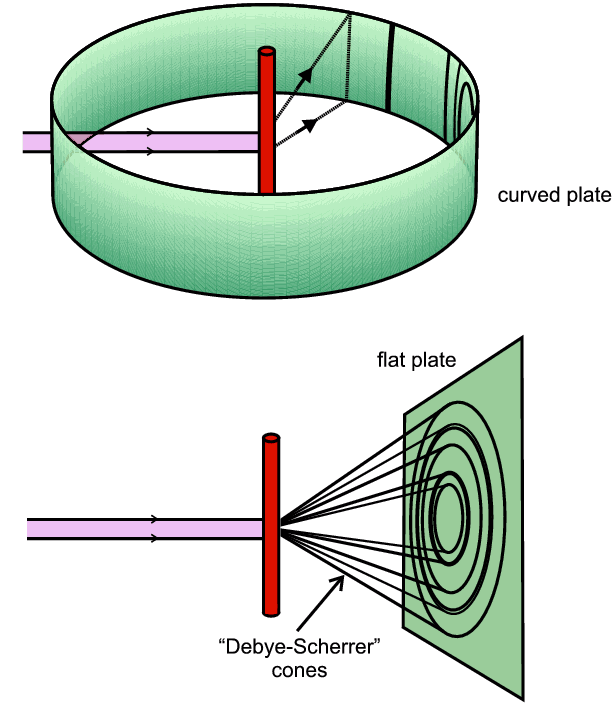 |
Mode (4): Use of Line/Area Detectors |
 Course Material Index
Course Material Index
 Section Index
Section Index
 Previous Page
Previous Page
 Next Page
Next Page
Mode (4): Use of Line/Area Detectors
The powder diffraction modes discussed so far all rely on using an electronic
X-ray detector which scans around the sample, the 2θ angle typically
covering say 10 to 90 degrees. While the detector is positioned at any given
2θ angle within this range, the X-rays being diffracted at other angles
are not being detected. This represents huge wastage and inefficiency since at
any one instant most of the diffraction information is being "thrown away" as
it were. For this reason a lot of effort has been directed into building
position sensitive detectors. These can detect diffracted X-ray photons
over a range of 2θ angles simultaneously, the 2θ angle of each
detected photon being determined by its arrival position on the detector. Such
position sensitive detectors are known as line or area detectors
depending on whether they collect in one or two dimensions respectively (see
below).
 Of course photographic film itself can be said to be the original position
sensitive detector, but it suffers from being very slow to process since the
photographic film first has to be developed and then the developed photographic
image has to be "read" and converted to an electronic form of input to a
computer system.
Of course photographic film itself can be said to be the original position
sensitive detector, but it suffers from being very slow to process since the
photographic film first has to be developed and then the developed photographic
image has to be "read" and converted to an electronic form of input to a
computer system.
Current position sensitive detectors are generally of two types: an electronic
form or an image plate. The electronic form is ultimately the more convenient
since information across the whole diffraction pattern is fed directly into the
computer. Examples of this technology will be discussed in more detail later in
the course.
During the 1990's we saw something of a throwback to the old methods of
photographic film, except the device was called an image plate and does
not require photographic development in the conventional sense. Image plates
are essentially a Japanese invention consisting of a Eu-doped phosphor powder
on a plastic sheet, the Eu2+ becoming excited to
Eu3+ by an incoming X-ray photon and remaining so for
some days until read out by a laser. The Eu3+ loses an
electron by a two-stage process, one of which emits detectable light. Therefore
the measured light intensity is proportional to the incident X-ray flux. The
slowest part of the process is the "reading" of the image which is done
typically in 1-10 minutes. Although still not intrinsically as convenient as a
completely electronic system, the component steps of image plate processing are
now sufficiently fast and automatic to make the whole process a viable
alternative. The image plate can be one-dimensional, as a thin strip, though it
is usually much more useful as a two-dimensional "flat" plate (thus viewing the
whole of the Debye-Scherrer rings, as they are known) or as a two-dimensional
"curved" plate which can be moved so as to continuously collect different
diffraction patterns with time. These concepts will become clearer later during
the course but in the meantime one can gain some idea of the function of image
plates from the illustrations below, which show two extreme examples: the first
pattern is of rather poor quality, but for good reason in that it has been
obtained from a minute amount of material being compressed between diamond
anvils, and hence shows texture effects, i.e. a poor signal to noise ratio and
somewhat "spotty" rings. However, good quality information can still be
obtained from such two-dimensional patterns by going around the Debye-Scherrer
rings and adding up all the contributions to improve the overall counting
statistics - this is often referred to as "integrating around the rings" and
will be re-visited in a later section on high pressure powder diffraction. By
contrast the second pattern (not to the same scale) has been obtained under
ideal conditions and displays sharp continuous rings.

 |
|
Courtesy of Dr. Malcolm McMahon, Edinburgh University and Dr.
Mark Roberts, Daresbury Laboratory. |
 Course Material Index
Course Material Index
 Section Index
Section Index
 Previous Page
Previous Page
 Next Page
Next Page



